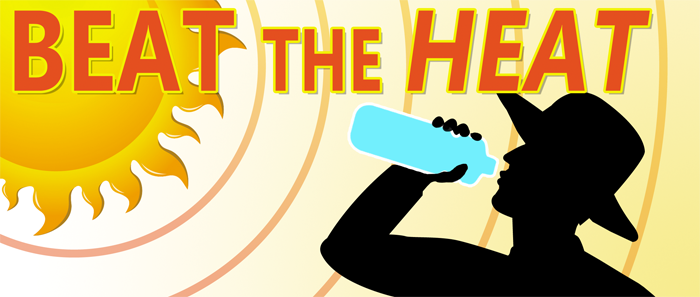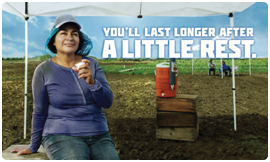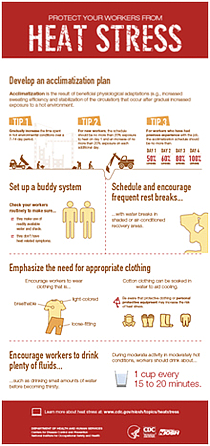

OSHA offers training materials in
multiple languages:
www.osha.gov/SLTC/heatillness
Join the launch of the Summer 2017 Beat the Heat campaign to prevent heat illness and deaths in agriculture. The U.S. Agricultural Safety and Health Centers (US Ag Centers) are joining the National Institute for Occupational Safety and Health/CDC to share critical information for farming, fishing, and forestry industries. We are asking employers, safety specialists and educators, to join us in preparing for the season and educating operators and workers.
Follow your regional U.S. Ag Safety Center over the next week for guidance on signs and symptoms, an employer preparedness checklist, handy tools and training resources. Join the movement to #BeatHeat #HeatSafety #USAGCenters #VenceAlCalor #VenceAlCalor2017 #NIOSH and share your own safety messages.
Find your regional U.S. Ag Center here: http://nasdonline.org/agcenter.php
Farming, fishing and forestry workers are at particular risk for heat illness because of exertional heat stress. Like athletes, during hard work, heat is built-up in the body. This, plus the external (environmental) sources can cause heat-related illnesses. Heat illness occur when the body can no longer cope and the body's physical and mental functions break down.

Heat illnesses and deaths are preventable. You can save lives by simply understanding:
In one case,
it was mid-May and about 78°F – not that hot. A 35-year-old worker started his job at 9 a.m. By early afternoon, he complained of feeling tired. As he went to lie down, he suddenly collapsed, became delirious, and had a seizure. His recorded temperature in the emergency room was 111°F. The cause of death was heat stroke. Chances of survival are pretty good if the body temperature is lowered to at least 102°F within 30 to 60 minutes. The worker described above probably died because of the intensity of his temperature.
Many cases of heat illness are misdiagnosed. By the time workers reach an emergency room, their temperature may have fallen enough that heat illnesses aren't suspected. Symptoms may be misclassified as those of a heart attack.
Under OSHA law, employers are responsible for providing workplaces free of known safety hazards. This includes protecting workers from extreme heat. In two States, California and Washington, there are heat exposure rules.
 RECOMMENDED RESOURCES
Materials are often in English and Spanish. OSHA includes some Vietnamese and Portuguese.
RECOMMENDED RESOURCES
Materials are often in English and Spanish. OSHA includes some Vietnamese and Portuguese.
OSHA's Campaign to Prevent Heat Illness in Outdoor Workers, OSHA
Heat Stress, NIOSH/CDC
Outdoor Heat Exposure Rule, Washington Department of Labor & Industries
California Campaign to Protect Outdoor Workers from Heat Illness. Cal/OSHA.
Heat Illness Prevention: Training Materials, Pacific Northwest Agricultural Safety and Health Center
Items in Heat/Cold Illnesses, Skin Cancer, National Ag Safety Database
US Ag Centers YouTube Channel. View heat illness prevention videos, and many others produced by other NIOSH Ag Centers colleagues! (English/Spanish)
GAMES / HANDS-ON LEARNING
OSHA Heat Training Guide, OSHA
Heat Stress Jeopardy PPT (English or Spanish)
True or false? Test your Heat Safety Knowledge (English)
¿Cierto o falso?¿Cuánto sabe sobre las enfermedades del calor? (Spanish)
Deadly Heat: Heat-Stress Safety Education Program
NEW! Free OSHA-NIOSH Heat Safety Tool App. Featuring real-time heat index and hourly forecasts, specific to your location, as well as heat safety recommendations.


Below are the NIOSH Ag Safety Centers, their web pages and links to their social media sites.
Find your regional center on the map, and follow your Ag Safety Center on social media for more health and safety information.

Disclaimer and Reproduction Information: Information in NASD does not represent NIOSH policy. Information included in NASD appears by permission of the author and/or copyright holder. More